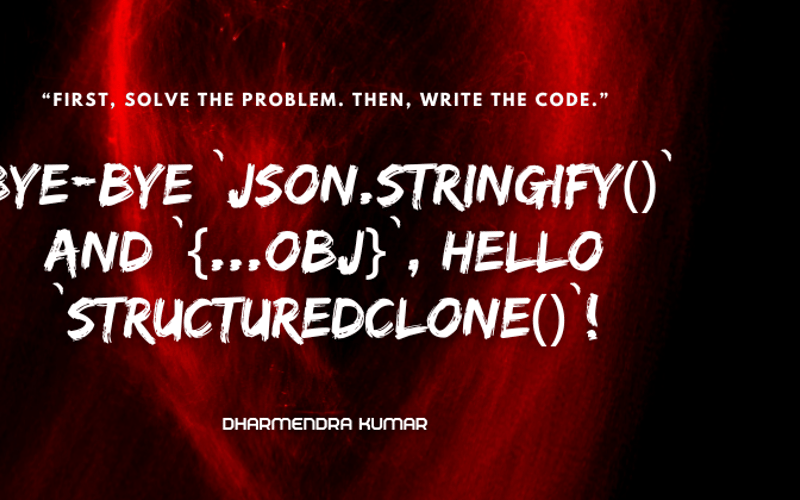1. Simple Object Cloning: The Basics
-
Using
{...obj}(Shallow Copy)
const original = { name: "Alice", details: { age: 25 } };
const shallowCopy = { ...original };
shallowCopy.details.age = 30;
console.log(original.details.age); // 30
console.log(shallowCopy.details.age); // 30
-
What’s happening?
- The spread operator
{...obj}only creates a shallow copy. Thedetailsobject is not deeply cloned, so changes toshallowCopy.detailsaffect the originaldetailsas well. -
Using
JSON.stringify()+JSON.parse()(Deep Copy)
- The spread operator
const original = { name: "Alice", details: { age: 25 } };
const deepCopy = JSON.parse(JSON.stringify(original));
deepCopy.details.age = 30;
console.log(original.details.age); // 25
console.log(deepCopy.details.age); // 30
-
What’s happening?
- This method creates a deep copy, but it has limitations: it cannot handle functions,
undefined, or circular references. -
Using
structuredClone()(Deep Copy)
- This method creates a deep copy, but it has limitations: it cannot handle functions,
const original = { name: "Alice", details: { age: 25 } };
const clone = structuredClone(original);
clone.details.age = 30;
console.log(original.details.age); // 25
console.log(clone.details.age); // 30
-
What’s happening?
-
structuredClone()creates a deep clone, preserving the structure without any of the limitations ofJSON.stringify()and handling complex data types like circular references andundefined.
-
2. Handling Circular References: A Challenge
-
Circular Reference with
{...obj}
const original = { name: "Alice" };
original.self = original;
// This will cause an error:
const shallowCopy = { ...original }; // TypeError: Converting circular structure to JSON
-
What’s happening?
-
{...obj}can’t handle circular references, resulting in an error. -
Circular Reference with
JSON.stringify()
-
const original = { name: "Alice" };
original.self = original;
// This will cause an error:
const jsonCopy = JSON.parse(JSON.stringify(original)); // TypeError: Converting circular structure to JSON
-
What’s happening?
-
JSON.stringify()also fails with circular references, throwing an error. -
Circular Reference with
structuredClone()
-
const original = { name: "Alice" };
original.self = original;
const clone = structuredClone(original);
console.log(clone !== original); // true
console.log(clone.self === clone); // true
-
What’s happening?
-
structuredClone()seamlessly handles circular references, creating a proper deep clone without errors.
-
3. Cloning with Functions and undefined: Another Test
const original = { name: "Alice", greet: () => "Hello!", value: undefined };
const shallowCopy = { ...original };
console.log(shallowCopy.greet()); // "Hello!"
console.log(shallowCopy.value); // undefined
-
What’s happening?
-
{...obj}copies functions andundefinedas expected, but only shallowly. -
Using
JSON.stringify()
-
const original = { name: "Alice", greet: () => "Hello!", value: undefined };
const jsonCopy = JSON.parse(JSON.stringify(original));
console.log(jsonCopy.greet); // undefined
console.log(jsonCopy.value); // undefined
-
What’s happening?
-
JSON.stringify()cannot serialize functions orundefined, resulting in their loss in the cloned object. -
Using
structuredClone()
-
const original = { name: "Alice", greet: () => "Hello!", value: undefined };
const clone = structuredClone(original);
console.log(clone.greet); // undefined
console.log(clone.value); // undefined
-
What’s happening?
-
structuredClone()also does not clone functions but preservesundefinedvalues, making it more reliable thanJSON.stringify()for complex objects.
-
4. Speed and Efficiency: A Performance Note
- Efficiency with Large Data
const largeArray = new Array(1e6).fill({ key: "value" });
console.time("structuredClone");
const clone = structuredClone(largeArray);
console.timeEnd("structuredClone");
console.time("JSON.stringify + JSON.parse");
const jsonCopy = JSON.parse(JSON.stringify(largeArray));
console.timeEnd("JSON.stringify + JSON.parse");
-
What’s happening?
-
structuredClone()is often faster thanJSON.stringify()+JSON.parse()for large, complex data, and avoids the pitfalls of serializing and deserializing.
-
5. Conclusion: Why structuredClone() is the Future
-
Reliability: Handles circular references, functions, and
undefinedvalues more predictably. - Efficiency: Performs deep cloning faster for large datasets and doesn’t require workarounds.
-
Simplicity: One method to rule them all—no more choosing between
{...obj},JSON.stringify(), or custom deep clone functions.
Source link
lol

